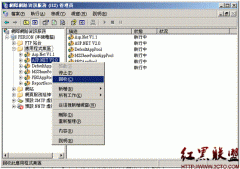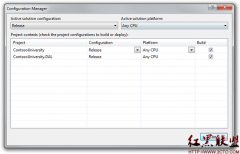asp.net 中将表单提交到另一页 Code-Behind的代码实现示例
来源:不详 责任编辑:admin 发表时间:2013-07-01 21:39 点击:次
The following shows a complete example of the code-behind file associated with the Web Forms page sending the information. Depending on whether you use Visual Basic or C#, make sure this sample is called Firstpage.aspx.vb or Firstpage.aspx.cs, respectively.
[Visual Basic]
Imports System
Public Class FirstPageClass :
Inherits System.Web.UI.Page
Protected first As System.Web.UI.WebControls.TextBox
Protected last As System.Web.UI.WebControls.TextBox
Protected Button1 As System.Web.UI.WebControls.Button
Public ReadOnly Property FirstName() As String
Get
' first is the name of a TextBox control.
Return first.Text
End Get
End Property
Public ReadOnly Property LastName() As String
Get
' last is the name of a TextBox control.
Return last.Text
End Get
End Property
Sub ButtonClicked(sender As Object, e As EventArgs)
Server.Transfer("secondpage.aspx")
End Sub
End Class
[C#]
using System;
public class FirstPageClass : System.Web.UI.Page
{
protected System.Web.UI.WebControls.TextBox first;
protected System.Web.UI.WebControls.TextBox last;
protected System.Web.UI.WebControls.Button Button1;
public string FirstName
{
get
{
return first.Text;
}
}
public string LastName
{
get
{
return last.Text;
}
}
void ButtonClicked(object sender, EventArgs e)
{
Server.Transfer("secondpage.aspx");
}
}
The following shows a complete example of how to create a Web Forms page with a code-behind file to pass the values of two TextBox controls to another Web Forms page. Make sure this sample is called Firstpage.aspx.
[Visual Basic]
<%@ Page Language="VB" Inherits="FirstPageClass" %>
<html>
<head>
</head>
<body>
<form runat="server">
First Name:
<asp:TextBox id="first"
runat="server"/>
<br>
Last Name:
<asp:TextBox id="last"
runat="server"/>
<br>
<asp:Button
id="Button1"
OnClick="ButtonClicked"
Text="Go to second page"
runat=server />
</form>
</body>
</html>
[C#]
<%@ Page Language="C#" Inherits="FirstPageClass" %>
<html>
<head>
</head>
<body>
<form runat="server">
First Name:
<asp:TextBox id="first"
runat="server"/>
<br>
Last Name:
<asp:TextBox id="last"
runat="server"/>
<br>
<asp:Button
id="Button1"
OnClick="ButtonClicked"
Text="Go to second page"
runat=server />
</form>
</body>
</html>
To receive Server control values from a different Web Forms page
The following shows a complete example of the code-behind file associated with the Web Forms page receiving the information. Depending on whether you use Visual Basic or C#, make sure this sample is called Secondpage.aspx.vb or Secondpage.aspx.cs, respectively.
[Visual Basic]
Imports System
Public Class SecondPageClass
Inherits System.Web.UI.Page
Protected DisplayLabel As System.Web.UI.WebControls.Label
Public fp As FirstPageClass
Sub Page_Load()
If Not IsPostBack Then
fp = CType(Context.Handler, FirstPageClass)
End If
End Sub
End Class
[C#]
using System;
public class SecondPageClass : System.Web.UI.Page
{
protected System.Web.UI.WebControls.Label DisplayLabel;
public FirstPageClass fp;
void Page_Load()
{
if (!IsPostBack)
{
fp = (FirstPageClass) Context.Handler;
}
}
}
The following shows a complete example of how to create a Web Forms page with a code-behind file to receive the values passed from a different Web Forms page. Make sure this sample is called Secondpage.aspx
[Visual Basic]
<%@ Page Language="VB" Inherits="SecondPageClass" %>
<%@ Reference Page="firstpage.aspx" %>
<html>
<head>
</head>
&l
[Visual Basic]
Imports System
Public Class FirstPageClass :
Inherits System.Web.UI.Page
Protected first As System.Web.UI.WebControls.TextBox
Protected last As System.Web.UI.WebControls.TextBox
Protected Button1 As System.Web.UI.WebControls.Button
Public ReadOnly Property FirstName() As String
Get
' first is the name of a TextBox control.
Return first.Text
End Get
End Property
Public ReadOnly Property LastName() As String
Get
' last is the name of a TextBox control.
Return last.Text
End Get
End Property
Sub ButtonClicked(sender As Object, e As EventArgs)
Server.Transfer("secondpage.aspx")
End Sub
End Class
[C#]
using System;
public class FirstPageClass : System.Web.UI.Page
{
protected System.Web.UI.WebControls.TextBox first;
protected System.Web.UI.WebControls.TextBox last;
protected System.Web.UI.WebControls.Button Button1;
public string FirstName
{
get
{
return first.Text;
}
}
public string LastName
{
get
{
return last.Text;
}
}
void ButtonClicked(object sender, EventArgs e)
{
Server.Transfer("secondpage.aspx");
}
}
The following shows a complete example of how to create a Web Forms page with a code-behind file to pass the values of two TextBox controls to another Web Forms page. Make sure this sample is called Firstpage.aspx.
[Visual Basic]
<%@ Page Language="VB" Inherits="FirstPageClass" %>
<html>
<head>
</head>
<body>
<form runat="server">
First Name:
<asp:TextBox id="first"
runat="server"/>
<br>
Last Name:
<asp:TextBox id="last"
runat="server"/>
<br>
<asp:Button
id="Button1"
OnClick="ButtonClicked"
Text="Go to second page"
runat=server />
</form>
</body>
</html>
[C#]
<%@ Page Language="C#" Inherits="FirstPageClass" %>
<html>
<head>
</head>
<body>
<form runat="server">
First Name:
<asp:TextBox id="first"
runat="server"/>
<br>
Last Name:
<asp:TextBox id="last"
runat="server"/>
<br>
<asp:Button
id="Button1"
OnClick="ButtonClicked"
Text="Go to second page"
runat=server />
</form>
</body>
</html>
To receive Server control values from a different Web Forms page
The following shows a complete example of the code-behind file associated with the Web Forms page receiving the information. Depending on whether you use Visual Basic or C#, make sure this sample is called Secondpage.aspx.vb or Secondpage.aspx.cs, respectively.
[Visual Basic]
Imports System
Public Class SecondPageClass
Inherits System.Web.UI.Page
Protected DisplayLabel As System.Web.UI.WebControls.Label
Public fp As FirstPageClass
Sub Page_Load()
If Not IsPostBack Then
fp = CType(Context.Handler, FirstPageClass)
End If
End Sub
End Class
[C#]
using System;
public class SecondPageClass : System.Web.UI.Page
{
protected System.Web.UI.WebControls.Label DisplayLabel;
public FirstPageClass fp;
void Page_Load()
{
if (!IsPostBack)
{
fp = (FirstPageClass) Context.Handler;
}
}
}
The following shows a complete example of how to create a Web Forms page with a code-behind file to receive the values passed from a different Web Forms page. Make sure this sample is called Secondpage.aspx
[Visual Basic]
<%@ Page Language="VB" Inherits="SecondPageClass" %>
<%@ Reference Page="firstpage.aspx" %>
<html>
<head>
</head>
&l
相关新闻>>
最新推荐更多>>>
- 发表评论
-
- 最新评论 进入详细评论页>>



